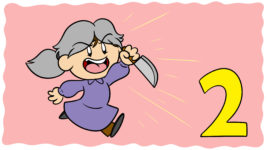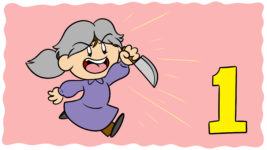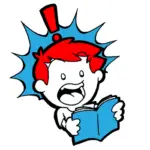Every reader has had that ‘wow’ moment when they put down a book. The moment when a story’s climax is so stunning that it can’t be absorbed right away. Such stories are few and far between but when they come along, they stay with your for days.
Trying to write that kind of climax is difficult and risky. Like an extreme sport there’s the thinnest of margins between being rewarded for your daring and making a fool of yourself.
For those brave enough to attempt it, this article presents the devices authors use to write a breath-taking climax and gives advice on how to implement them yourself.
Does the climax have to be at the end?
No, but it should be. The climax is the most exciting, upsetting or amazing moment in your story. The moment when the reader’s commitment pays off. The satisfaction that comes from that moment is the feeling you want to leave your reader with.
With the whole novel to build up their involvement and bring plot elements together, the end of your novel is the natural home of the climax. It’s the point where you’ve had the most time to prepare, and where it benefits you the most.
There’s a little debate that the end of a novel is where a story should climax, but when they say this, most authors mean the final act of the story or the last few chapters. The dangerous truth is that for a really out-of-this world climax it needs to be the last few pages.
Don’t linger
No matter what follows the climax you’re going downhill. The reader isn’t going to feel that same high again, and so every sentence that follows is worse than what they’ve already read. Not only that but more information encroaches on their experience, diluting that powerful emotion that should be kept as pure as possible.
When it comes to your story’s climax, the best thing you can do is blow their minds then run away. As with so many things in writing the obstacle that most often gets in the way of this device is the author’s ego. Ending the story on the emotional climax often means you don’t get to explain the after-effects. You don’t get to wrap things up for the characters and you don’t get to finish your story with a comfortable epilogue.
All writers suffer from this to some extent, and when you’re writing a climax there’s a direct trade-off between your own satisfaction and the reader’s emotional reaction. The more post-climax events you can let go, the more amazing the climax becomes.
The key is to write the characters and plot in such a way that the reader knows what happens after the climax. The temptation to keep writing will still be there but knowing it’s not necessary should help you resist.
Irvine Welsh’s novel Filth climaxes with a shocking act of violence in front of the last person on Earth who should witness it. The book ends immediately, not mentioning any sort of reaction, and yet the reader knows exactly what kind of devastation will follow. Welsh loses nothing by skipping an aftermath the reader can already envision, instead ending on a truly jaw-dropping moment.
If your characters are fully realized and the stakes of the plot are understood then the reader will know the cost of the climax without you explaining it.
You only get one
The climax is the most extreme moment of your story, not just a quite extreme moment near the end.
Your story can’t have two climaxes, so if you want to stagger your reader you need to make sure the final peak really is the biggest.
Douglas Adams’ The Hitchhiker’s Guide to the Galaxyseries is filled with wit, truly evocative moments and surprisingly dark humor. Despite having a lot of incredible moments to contend with, Adams finishes the series with a true climax.
The fifth book in the series,Mostly Harmless, (spoiler alert) ends with the destruction of Earth and the (heavily implied) death of all the main characters. There are barely two paragraphs between the realization of what’s about to happen and it being over.
The ending had to be both abrupt and total to top the rest of the series, and Adams pulls off a climax that divides fans by taste but undoubtedly leaves the reader stunned.
Suspense or Surprise
There are two ways to give your end-of-novel climax impact. The first is to spring it out of nowhere, as Adams does in Mostly Harmless. While the event should still make sense within the plot, there’s incredible power in blind-siding the audience.
We see this all the time in movies, with cars zooming in from off-screen to fell a character who’s finally got their life together. Be a little more meticulous than this by planting clues of the end shock along the way – Adams reveals the Earth’s destruction by referring back to a passage in the third book of the Hitchhiker series – while still keeping your reader in the dark.
The opposite side of the coin, although just as effective a device, is to use suspense to build tension. Forcing the release of this tension at the book’s climax concentrates the reader’s entire emotional experience into a single moment.
Throughout Barney’s Version, Mordecai Richler teases the reader with whether the titular protagonist murdered his best friend. First it seems certain he did, then that he didn’t, and the reader oscillates between believing the friend got what he deserved and desperately wanting Barney to be innocent.
It’s not until the last page that the reader gets their answer, and all the faith, hope and worry that they’ve poured into the question is focused on a single line for an exhausting emotional climax.
Handle with care
Each of the devices above can be either effective or disastrous. While it’s brilliant writing to end a story at the emotional pinnacle you better be sure that readers understand what would happen afterwards, or they’ll go away feeling short-changed and confused.
Likewise, not every story is meant to have its most significant moment late on, and a surprise ending can feel tacked on if done badly.
The potential for great reward comes with great risk but if you can nail a climactic ending then you’ll have written the kind of book people force on their friends.
If this has made you determined to write an all-action climax then check out our article Here’s How To Write A Damn Good Fight Scene. Or if all this talk of abrupt endings seems too severe try Writing An Epilogue Can Be Useful (As Long As You Do It Right.)
Which novels have given you that ‘wow’ moment, and which missed the mark? Let us know in the comments.




25 thoughts on “Here’s How To Write A Killer Climax That Leaves Readers Breathless”
I definitely love your articles.
The best climax I’ve ever read is when Ned Stark dies (first book of GOT, Martin). In which of the 2 categories mentioned above would you put it? I bet the second one.
Thanks very much Boostwriter,
You’re right, definitely the second, although I think the thing that’s made GoT such a success is that it manages to create an aura of suspense around its surprises. You don’t know where the next jolt is coming from, but you know it’s coming.
Best,
Rob
The book that left me feeling absolutely stunned at the end was one by Bill Pronzini, titled “Nothing But the Night”. Two of my friends read it and had the same reaction I had.
Mr. Wood, I found your articles very interesting and helpful. I’m working on the last chapter of a book, and I’m unable to decide the ending, but one thing is for certain, I will void an epilogue.
This was helpful! I like what you said about the climax being at the very end, but that is not always necessary, in my opinion. When I read books, I like it when there is another chapter or so at the end, even for books with strong climaxes. Possible one of the strongest (and emotionally wracking) climaxes I’ve ever read was in the book Code Name Verity, and there was more afterwards. Thanks for sharing writing help!
Hi atreeofblue,
No problem, thanks for the feedback. While I haven’t read Code Name Verity I have no problem believing an amazing climax was followed by more story. I do tend to believe, however, that if it’s a story that suits a climactic ending then that climax will be more impactful the closer to the very end of the story it occurs.
It’s not that I think the reader shouldn’t know the result of the climax, I just believe there’s usually a way of giving them that knowledge whilst also ending at the point which gives you maximum impact. Often that’s achieved by consistent and well realised characterisation – we know how the characters will react to the climax without seeing it.
Of course the fantastic thing about art is that there are always arm-fulls of examples that fly in the face of the rule.
Best,
Rob
I disagree with this article. I don’t think that the climax should be so close to the end, most modern popular novels, which most authors would be writing, call for a climax about 66% percent of the way into the book, leaving cool down time and reaction time, except for cases like Adams’ where there is no real reaction because everyone dies.
Hi Sami,
Thanks for your thoughts. The article’s about making the most of your climax, so it may not be for every style – as I said in the introduction it can be a risky business. If your book is more about the reactions and cool down than the climax itself you may indeed prefer to place it at the 66% mark. If, however, you want the climax to have maximum effect I think it’s important to find a way to ‘leave’ the reader with it.
Reactions and consequences are of course important, but the trick to really blowing a reader away is to make them contemplate those parts of the story on their own.
A great example is ‘Of Mice and Men’. Through the novel we see how little control field workers have over their own lives, and how they fritter their money away on trivial pleasures just to feel human. The protagonists, George and Lennie, are different, saving up their money for a farm which will allow them to live independently. At the end of the novel George is forced to kill Lennie to save him from a lynching, and we leave him just a few minutes after he has done so.
The tragic consequence of this act is that George’s dream is dead. We’ve seen through the novel the life that he will now fall into, and we know he’ll never escape. Steinbeck is such a master that we understand who George is, the world he lives in, and so know what must come next without needing to be told. We don’t need any more information to know what follows, and the fact that we’re left to contemplate it alone makes it so much more powerful than if it was all laid out in front of us. If a third of ‘Of Mice and Men’ was a man miserably squandering his cash on gambling and alcohol it might not be such a classic.
For a more recent example I’d recommend Jennifer Egan’s ‘Safari’ which offers a more complex version of this device.
http://www.newyorker.com/magazine/2010/01/11/safari-3
In this story we get glimpses into each major character’s future, seeing how their lives will unravel and end, but still the story ends with a climactic moment (in this case a comment that introduces a new, menacing, context.)
You could also check out the comic ‘Sweet Tooth‘, which dedicates 1/40 of its run to post-climax events (even though the pre-climax story is a year at most, and the post-climax events around sixty or seventy years.)
I agree that the majority of novelists might not use their climaxes as described, but as I said it takes a) skill, b) trust in your audience and (perhaps most rarely) c) the ability to cut short a story that you desperately want to tell. Most authors want to explore the fallout, and they can do it well, but they sacrifice a greater emotional impact for the satisfaction of doing so. Many authors may place their climax at the 66% mark, but it’s the ones who make it 99% of the way through that we’re still talking about decades later.
Best,
Rob
Rob,
Agree entirely. I loved the ending of Dune, when all (or at least most) of the wrongs are avenged. It is really satisfying. Unfortunately the remaining books of the series fall flat on their face after the awesome first one.
Best,
Chris
Hi Chris,
Thanks for commenting and providing a great example.
Best,
Rob
Great article. I am in the process of writing my climax for my trilogy, but have been struggling to write it for a long time now. I just feel every time I begin writing it, I am messing it up and will ruin the whole story. Any help would be wonderful.
Hi Jacob,
Thanks for getting in contact. I’ve included some articles below that should be useful.
//www.standoutbooks.com/how-to-write-a-book-series/
//www.standoutbooks.com/avoid-anticlimactic-ending/
//www.standoutbooks.com/heres-tortoise-can-help-finally-finish-novel/
Best,
Rob
Dear Robert Wood,
I’m a filmmaker from India.
Thanks for the article and these links. They served me some important knowledge.
I concur. And thank you! This one was really useful. Well, my favorite endings were ~ The fault in our stars and Looking for Alaska
both by John Green, 13 reasons why and a few more. I haven’t read much such books. Could you please suggest me some to have a real good idea about ending a story’s climax?
My pleasure, Prerna. Was there a specific element of a book’s climax you wanted advice on?
I know I’m over four years late, but thank you for writing this! I came here because I’m reaching the climax in my first draft, which I originally planned for an Epilogue to follow because my protagonist dies at the very end. I thought it would be leaving the reader hanging otherwise, but I think I’ll give this “Killer Climax” a shot.
Hi Endeverse,
Not at all – there’s a reason we leave our articles up. I’m really glad it was useful, and good luck with your project.
Best,
Rob
I think the book that left me with a “wow” sensation is probably J.K. Rowling’s books on Harry Potter and F.E. Higgins’ book : The Eyeball collector. Thank you for this article! It was really helpful!
Thanks for sharing, Morgan. The nature of the Harry Potter books – a year of events that build towards a specific payoff – is tailor-made for climaxes that amaze the reader. I haven’t read The Eyeball Collector, but judging by that title, I’m not surprised it had a ‘wow’ in it.
– Rob
I’ve been stuck with the climax for months now. I feel like it’s marginally harder to nail it down with romance than anything else, if only because every ending ever has been done and redone a million times. Your advice is solid and I’m definitely using it for other projects (I can’t write one thing at a time for too long so I work on different stories depending on mood) but with romance… how do you achieve that, exactly? Furthermore, how do you come up with an ending that will actually resonate with the reader, given the genre itself restricts from an ‘epic’ climax unless, I don’t know, you reuse the same misunderstanding/life separating the couple events every other novel seems to do?
Hi maf,
Thanks for commenting and for such an interesting question. One unavoidable fact when wrestling with genre writing is that a frequently used tool or trope is often used so often because it works. If the familiarity of a given choice is likely to be an obstacle for a reader, a solution is needed, but if it isn’t, it may not need fixing.
Otherwise, it’s about paying off on the ideas and themes you’ve established in the story prior. Scale isn’t objective – small events can be made to feel epic if they’re presented as such, but the entirety of the story has to work towards this. For example, what concepts underlie the romance in your story? Is romance redemptive, humanizing, maddening? How can these ideas be pronounced and then resolved in a climax?
Best,
Rob
I see. Thank you, I’ll try that approach. I’ve heard it’s always best to ‘close’ the story thematically so I’ll do that too.
Hey Rob,
I’m writing and directing a short film, and I’m finding it difficult to come up with a climax for my story. The plot is sort-of science fiction-based, but I don’t want the climax to end in an extreme out of this world event. The main character is experiencing some events that mess with her teen life, but I don’t want the resolution to be her fighting a God or some crazy giant robot. I want a more down to earth ending. Any tips would help. Thank you.
Best,
Jacob
Hi Jacob,
It would really depend on the themes and prior events of your story. But if you want an effective climax that doesn’t play into cliche, it might be worth working towards a reveal that changes the context of a prior moment. The seemingly innocuous event was actually a death sentence, or something similar (e.g. Ozymandias’ “I did it thirty-five minutes ago”). This allows for a quiet scene that still carries a lot of weight.
Best,
Rob
Wow, Mr. Wood, this article is amazing! I am going into grade 11 this September, I love writing and English class. I’m entering my first writing contest this summer, your article helped me get in the mood to write an exciting short story! Thank you!
Absolutely my pleasure, Hannah. I hope the writing contest went well, but even if you didn’t get the result you wanted, make sure to keep submitting your work. No-one wins them all, but you ONLY win if you enter.